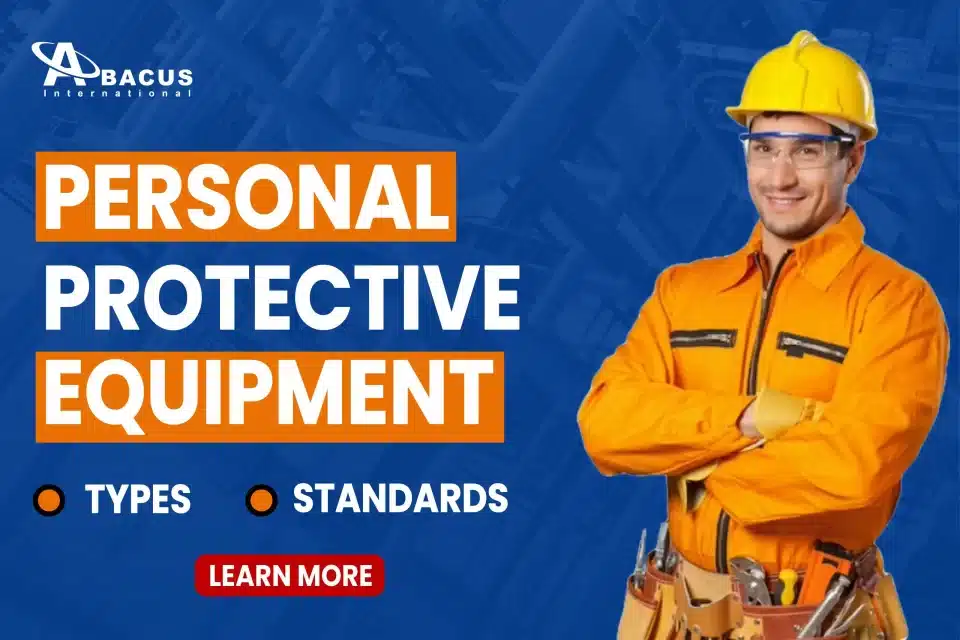Personal Protective Equipment, commonly referred to as PPE, encompasses various items designed to protect individuals from workplace hazards or environmental risks. These items are crucial in ensuring safety and minimizing the potential for injury or illness in various settings. PPE acts as a barrier between the user’s body and different workplace hazards. PPE becomes necessary when individuals are exposed to potential hazards in their work environment. This includes situations involving:
- Chemical exposure
- Physical hazards like falling objects or sharp materials
- Biological risks, such as exposure to infectious agents
- Radiation or intense light exposure
Types of Personal Protective Equipment
- Head Protection: Headgear like helmets safeguards against head injuries caused by falling objects or impact hazards.
- Eye and Face Protection: Goggles, face shields, and safety glasses shield the eyes and face from chemicals, flying debris, or harmful light radiation.
- Respiratory Protection: Respirators and masks filter out airborne contaminants, preventing inhalation of harmful particles or gases.
- Hand Protection: Gloves shield hands from cuts, burns, chemicals, and other risks present in the work environment.
- Body Protection: Coveralls, vests, or full-body suits safeguard against various workplace hazards, including chemicals, heat, or biohazards.
- Foot Protection: Safety shoes or boots protect against punctures, electrical hazards, and slips.
Standards and Regulations for PPE
Regulatory bodies such as OSHA (Occupational Safety and Health Administration) establish guidelines ensuring PPE meets safety standards and quality requirements. Compliance with these standards is vital for workplace safety.
- Selecting the appropriate PPE involves assessing the potential risks, choosing items that adequately protect against identified hazards, ensuring proper fitting, and maintaining the equipment regularly. This selection process differs across industries based on the specific risks involved.
- Industries like healthcare, construction, and manufacturing rely heavily on PPE to protect workers from industry-specific hazards. Proper use and adherence to PPE protocols are essential in these sectors to mitigate risks effectively.
- However, challenges persist in PPE usage, including comfort, usability, ensuring proper training, and managing associated costs. Overcoming these challenges remains crucial to ensuring widespread adoption and effective use of PPE.
- In the context of pandemics or disease outbreaks, PPE plays a critical role in controlling the spread of infectious diseases. During such times, the correct and consistent use of PPE becomes imperative for healthcare workers and the general population.
Conclusion
Personal Protective Equipment stands as a cornerstone in ensuring workplace safety across various industries. Its proper selection, use, and maintenance are pivotal in safeguarding individuals from potential hazards. As technology advances, innovations in PPE continue to evolve, promising improved safety measures and sustainability in manufacturing.
Frequently Asked Questions (FAQs)
What are the most commonly used PPE?
The most commonly used PPE across industries are:
- Safety Glasses/Goggles: Protect eyes from impact, dust, and chemical splashes.
- Gloves: Shield hands from chemicals, cuts, or contaminants.
- Helmets/Hard Hats: Guard against head injuries from falling objects or electrical hazards.
- Respirators/Masks: Prevent inhalation of harmful particles, gases, or vapors.
- Earplugs/Ear Muffs: Reduce noise exposure.
- Safety Shoes/Boots: Shield feet from impact, punctures, or electrical hazards.
How do you use PPE correctly?
Using PPE correctly is crucial for its effectiveness:
- Proper Fit: Ensure a snug but comfortable fit without compromising movement.
- Training: Educate users on how to wear, adjust, and maintain PPE.
- Inspection and Maintenance: Regularly check for damage and wear; replace if compromised.
- Consistency: Wear PPE consistently in relevant work areas, even if hazards seem minimal.
- Storage and Disposal: Store PPE properly to maintain its integrity and dispose of it according to guidelines.

